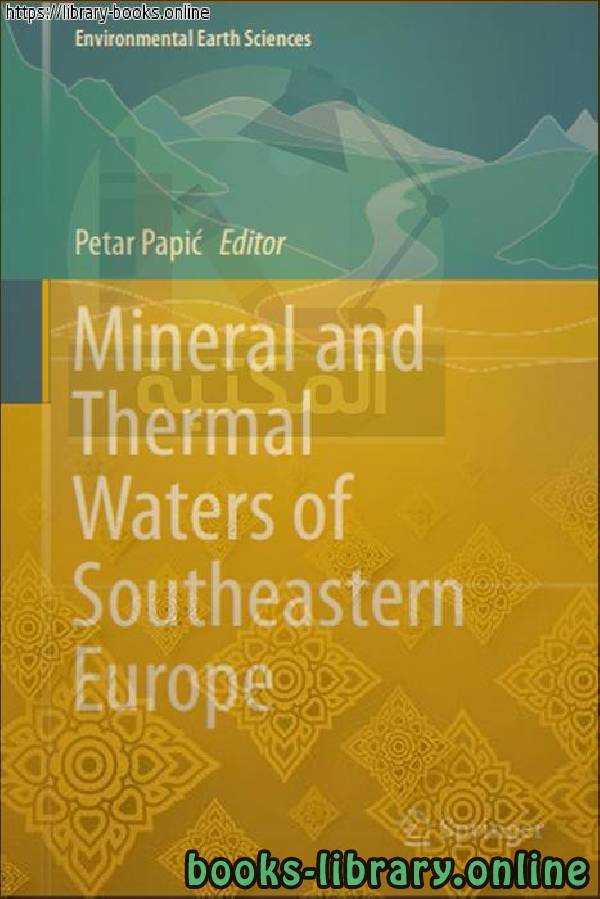📘 قراءة كتاب Mineral and Thermal Waters of Southeastern Europe أونلاين


Biologically
Biology is a natural science that is concerned with the study of life, its various forms and its function, how these organisms interact with each other and with the surrounding environment. The word biology in Greek is made up of two words: bio (βίος) meaning life. And loggia (-λογία) means science or study. Biology: the similarity of vegetation and animal cover on the edges of the African and American states, and the existence of the same fossil.
Branches of biology
Biology is an ancient science thousands of years old and modern biology began in the nineteenth century. This science has multiple branches. Among them are:
Anatomy
Botany
Biochemia
Biogeography
Biofisia
Cytology or cell science
Ecology or environmental science
نبذه عن الكتاب:
Geology of South-Eastern Europe
Vladica Cvetkovic, Dejan Prelević and Stefan Schmid
Abstract The region of South-Eastern Europe (SEE) occupies an important
segment of the Alpine–Himalayan collisional orogenic belt and consists of several
Phanerozoic mobile belts. The SEE region inherits its geology from the evolution of
the Vardar Tethys ocean, which existed in-between the Eurasian (Europe) and
Gondwana (Africa) continental plates and which relicts presently occur along the
Vardar–Tethyan mega-suture. This synthesis, therefore, consists of (1) pre-, (2) synand (3) post-Vardar–Tethyan geology of SEE. Pre-Vardar–Tethyan geology on the
European side is reflected by geological units formed from Precambrian to
Mesozoic times and include the Moesian platform, the Dacia mega-unit and the
Rhodopes. On the Gondwana side, it is represented by the External Dinarides, the
Dalmatian-Ionian Zone and Stable Adria (Apulia), all principally formed from
Paleozoic to Mesozoic times. The Syn-Vardar–Tethyan units encompass the bulk of
the geological framework of SEE. They are a physical record of the former existence of the Mesozoic oceanic lithosphere, being represented dominantly by
ophiolites and trench/accretionary wedge (mélange) assemblages, which originated
and were reworked during the life-span of the Vardar Tethys. The Post-Vardar–
Tethyan geological evolution refers to the time period from the final closure of the
Vardar Tethys until present. It comprises all rocks that stratigraphically overlie
the Vardar–Tethyan mega-suture and seal the contacts between the mega-suture and
the surrounding geological units. This is the time characterized by rapid extension
coupled with exhumation of the lower crustal material, high heat flow, both
intrusive and extrusive magmatism and considerable lithosphere thinning.
Biology
Human biology
Who is the founder of biology?
The importance of biology
Areas of work in the field of biology
Theories of biology
Research on biology for the first grade of secondary school
Human biology
سنة النشر : 2016م / 1437هـ .
حجم الكتاب عند التحميل : 5.475 .
نوع الكتاب : pdf.
عداد القراءة:
اذا اعجبك الكتاب فضلاً اضغط على أعجبني و يمكنك تحميله من هنا:

شكرًا لمساهمتكم
شكراً لمساهمتكم معنا في الإرتقاء بمستوى المكتبة ، يمكنكم االتبليغ عن اخطاء او سوء اختيار للكتب وتصنيفها ومحتواها ، أو كتاب يُمنع نشره ، او محمي بحقوق طبع ونشر ، فضلاً قم بالتبليغ عن الكتاب المُخالف:
 قبل تحميل الكتاب ..
قبل تحميل الكتاب ..
يجب ان يتوفر لديكم برنامج تشغيل وقراءة ملفات pdf
يمكن تحميلة من هنا 'http://get.adobe.com/reader/'


 منصّة المكتبة
منصّة المكتبة 